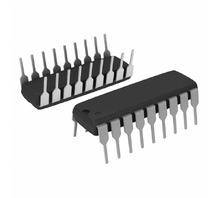Manufacturer Part Number
ULN2804A
Manufacturer
STMicroelectronics
Introduction
High-voltage, high-current Darlington transistor arrays
Designed to interface between low-level logic circuitry and high-power loads
Product Features and Performance
8 NPN Darlington-connected transistors
Capable of driving inductive loads such as relays, solenoids, and high-power lamps
High-voltage outputs up to 50V
High-current outputs up to 500mA per driver
Low saturation voltage of 1.6V @ 500mA, 350mA
High DC current gain of 1000 @ 350mA, 2V
Operating temperature range of -20°C to 150°C
Product Advantages
Simplifies power interface design
Allows direct control of inductive loads from low-level logic
Provides high-current, high-voltage drive capability
Compact 18-pin DIP package for easy through-hole mounting
Key Technical Parameters
Manufacturer Part Number: ULN2804A
Package: 18-pin Dual In-Line Package (18-DIP)
Voltage Collector Emitter Breakdown (Max): 50V
Current Collector (Ic) (Max): 500mA
Vce Saturation (Max) @ Ib, Ic: 1.6V @ 500A, 350mA
DC Current Gain (hFE) (Min) @ Ic, Vce: 1000 @ 350mA, 2V
Quality and Safety Features
RoHS3 compliant
Designed for reliable, long-term operation
Compatibility
Suitable for a wide range of applications requiring high-voltage, high-current Darlington transistor arrays
Application Areas
Driving inductive loads such as relays, solenoids, and high-power lamps
Interface between low-level logic circuitry and high-power loads
Automotive electronics
Industrial control systems
Consumer electronics
Product Lifecycle
The ULN2804A is an established and widely-used product, with no indication of discontinuation.
Replacement or upgrade options are available if needed.
Key Reasons to Choose ULN2804A
Reliable high-voltage, high-current Darlington transistor array
Simplifies power interface design and allows direct control of inductive loads
Compact 18-pin DIP package for easy through-hole mounting
Wide operating temperature range of -20°C to 150°C
RoHS3 compliant for environmental responsibility
Proven performance and long-term reliability



 ULN2803LWAllegro MicroSystems
ULN2803LWAllegro MicroSystems